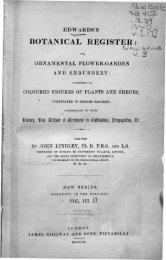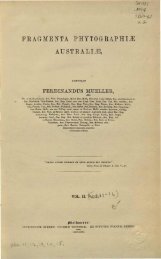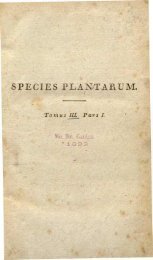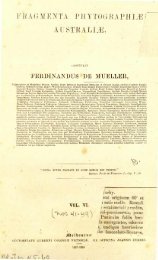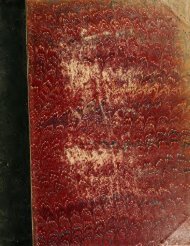Botanical Magazine 106 - 1880.pdf - hibiscus.org
Botanical Magazine 106 - 1880.pdf - hibiscus.org
Botanical Magazine 106 - 1880.pdf - hibiscus.org
You also want an ePaper? Increase the reach of your titles
YUMPU automatically turns print PDFs into web optimized ePapers that Google loves.
TAB. 6481.<br />
HYPERICUM J2GYPTIACÜM.<br />
Native ofN. Africa and the Levant.<br />
Nat. Ord. HYPEEICINE«.•Tribe HYPEBICE^:.<br />
Genus HYPEEICUM, Linn.; (Benth. et Hook. f. Gen. PL vol. i. p. 165.)<br />
HYPEEICUM (Triadenia) •gyptiacum ; fruticosum, erectum v. decumbens, glaberri-<br />
mum, glaucum, foliis parvis oppositis ovatis acutis enerviis coriaceis superne<br />
concavis subtus subcarinatis, floribus ad apices ratnulorum lateralium subsessili-<br />
bus parvis, sepalis oblongis obtusis eglandulosis, petalis obovato-spathulatis supra<br />
unguem medio tuberculatis, pbalangis 3 staminura glandulis liypogyais alter-<br />
nantibus, carpellis 3 brevibus, stylis brevissimis, ovulis paucis.<br />
H. ajgyptiacum, Linn. Am•n. Acad. vol. viii. p. 323, t. 8, f. 3; DC. Prodr. vol. i.<br />
p. 549 ; Bot. Reg. t. 196.<br />
Triadenia microphylla, et thymifolia, Spach in Ann. 8c. Nat. ser. 2, vol. v. p. 173,<br />
t. 4.<br />
T. segyptiaca, Boiss. Fl. Orient, vol. i. p. 783.<br />
The specific name of this pretty little shrub is unfor-<br />
tunate, for it has never, as far as at present known, been<br />
found in Egypt. It has however an extensive range in the<br />
Mediterranean islands and coasts ; I have examined speci-<br />
mens from Lampedusa, Cephalonia, Zante, and Sphacteria,<br />
and it hence may possibly occur on the coast of Egypt<br />
westward of the Nile, which has never been explored by a<br />
botanist. Its western limit is Cape Agadir in Southern<br />
Morocco, on the shores of the Atlantic, where it has boon<br />
discovered by a collector employed by M. Cosson in that<br />
district (which is impenetrable by Christians) since the<br />
publication of my fellow-traveller Mr. Ball's " Spicilegium<br />
Maroccanum." It is difficult to believe that IL maritimum<br />
Sieber and H. Webbii Spach, which differ only in the length<br />
of the styles, are anything but sexual states of IL •gyptia-<br />
cum : of these the first is a native of Crete, as well as of<br />
Malta, whence we have specimens from Mr. Duthie, and the<br />
latter of the Ionian Islands.<br />
In its native state II. •gyptiacum is a very low-growing,<br />
often prostrate, small shrub, with very woody stout trunk<br />
MABCH 1ST, 1880.




